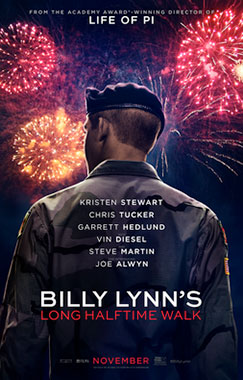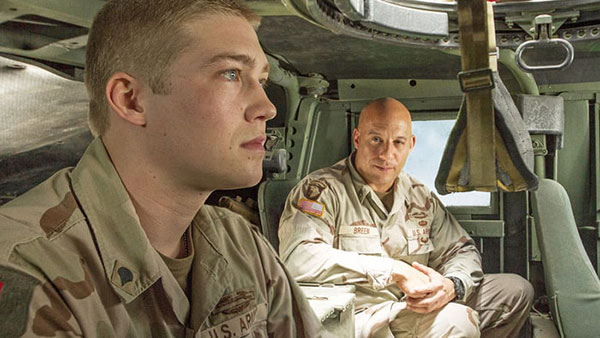“Billy Lynn’s Long Halftime Walk” Stumbles Mid-Field
Written by: Christopher Llewellyn Reed | November 21st, 2016

Billy Lynn’s Long Halftime Walk (Ang Lee, 2016) 1½ stars out of 4
Ang Lee has made many fine films, some of them great. Among the latter, I would count both Brokeback Mountain and Life of Pi; among the former, Eat Drink Man Woman, Sense and Sensibility, The Ice Storm, and Crouching Tiger, Hidden Dragon. He has also had one unmitigated misfire: 2003’s Hulk (no “The,” just “Hulk”), which stands alone as that rare film by Lee that was both box-office and critical flop, failing to make back its production budget domestically (though it recouped the loss when we add in international sales), and receiving a general, if neither uniform nor unanimous, drubbing from movie reviewers around the globe. Nobody’s perfect.
Now comes Billy Lynn’s Long Halftime Walk, based on Ben Fountain’s 2012 book. The original source material is both frustrating and deeply satisfying: frustrating because its rambling structure frequently meanders beyond its story; satisfying because it is a much-needed critique of our society’s hypocrisy when it comes to war. Billy is a young man more or less impressed into the U.S. Army after an act of vandalism, who returns home on a Thanksgiving-week victory tour after he and the members of his unit win a battle over Iraqi insurgents. Videotaped by an embedded Fox News crew, this victory is used by the Bush Administration (the book takes place in the mid-2000s) to increase public support for the war. And so the boys of Bravo Squad are fêted and dined on a cross-country trip which ends in Dallas on Thanksgiving Day, during a Cowboys-Bears football game. The entire present-day plot of the novel takes place before, during and after that game, interspersed with flashbacks to the war and Billy’s life before the war. What passes for narrative allows author Fountain to set up encounter after encounter where the general words of support and encouragement spoken to the soldiers by the public are revealed as hollow. Mass consumption is all Americans think about.
Lee’s film is very much like the book in structure, albeit simplified. All the major characters remain, and the central question of the novel – should Billy stay in the army or turn deserter, as his sister implores – is the same. This is all for the good, since the book raises important issues, but also bad, since the time we spend in the stadium is distinctly undramatic. Indeed, it may be even less engaging than similar scenes in the book, since the cast of young actors who play the soldiers are not up to the challenge of shouldering the weight of the story. Sadly, chief among those who fall short is Billy Lynn, himself, portrayed by newcomer Joe Alwyn. He is not alone, however. When your movie’s biggest emotional scenes are given to Vin Diesel (Riddick), a fine performer in the right kind of flick but not exactly a powerhouse of a thespian, you know you have a problem. Perhaps the only actor who acquits herself honorably is Kristen Stewart (Certain Women), as the sister encouraging Billy to quit. Even veteran Steve Martin (It’s Complicated) fares poorly as what passes for the movie’s unctuous villain. Fellow comic Chris Tucker (Rush Hour) comes across only slightly better, while Garrett Hedlund, as Billy’s commander, can’t get past his shtick from last year’s Pan.

Leaving the actors aside, however, the real problem with the film is the way it is shot. Although most of us will never be able to see the movie in its native 120 frames-per-second format (I only saw the 24fps version), we are still subjected to a roving camera that never quite seems to find its subject, crossing the 180-degree line at will, disrupting our sense of perspective. When that camera does stop, the actors often turn to it and break the fourth wall, looking directly into the lens for no discernible aesthetic reason. It’s odd and off-putting, and when combined with mannered performances it pushes us out of the story. My guess is that the choice to use the high frame rate was made to create the effect of a live sports event, using the stadium setting as inspiration, to heighten the emotional content. The other disruptions were most likely intended to shake us out of our own complacency as viewers. I get it, but it’s neither pleasant nor effective. Whether or not 120fps would achieve a better result is a judgement to be reserved for the lucky few who catch the movie in select theaters in New York and Los Angeles. The rest of us just get the muddled remains.

